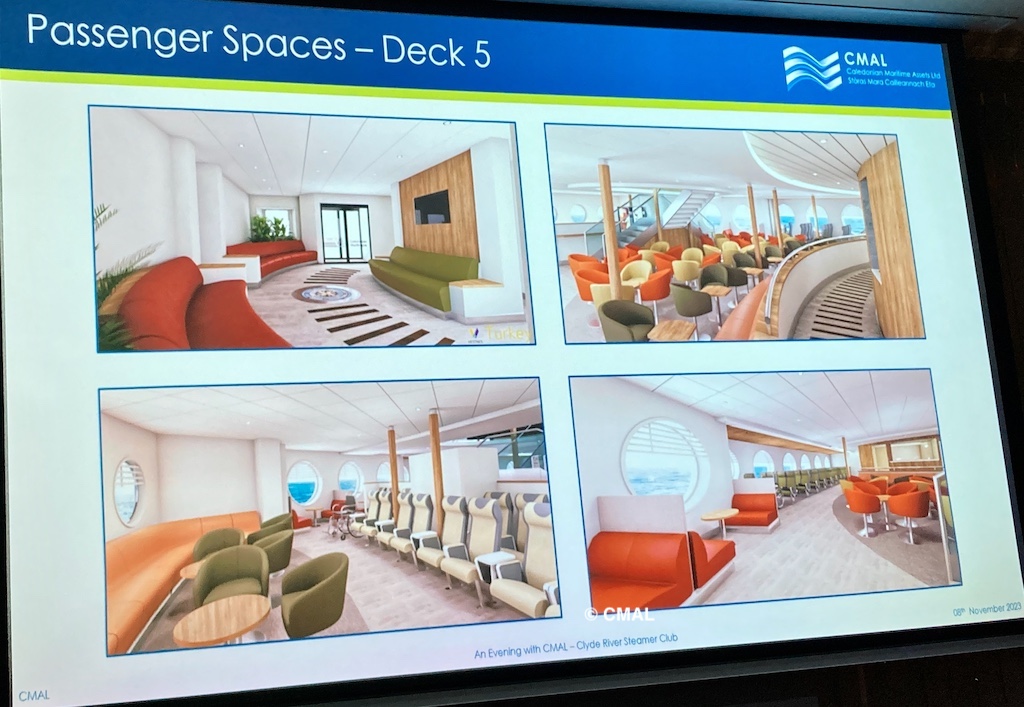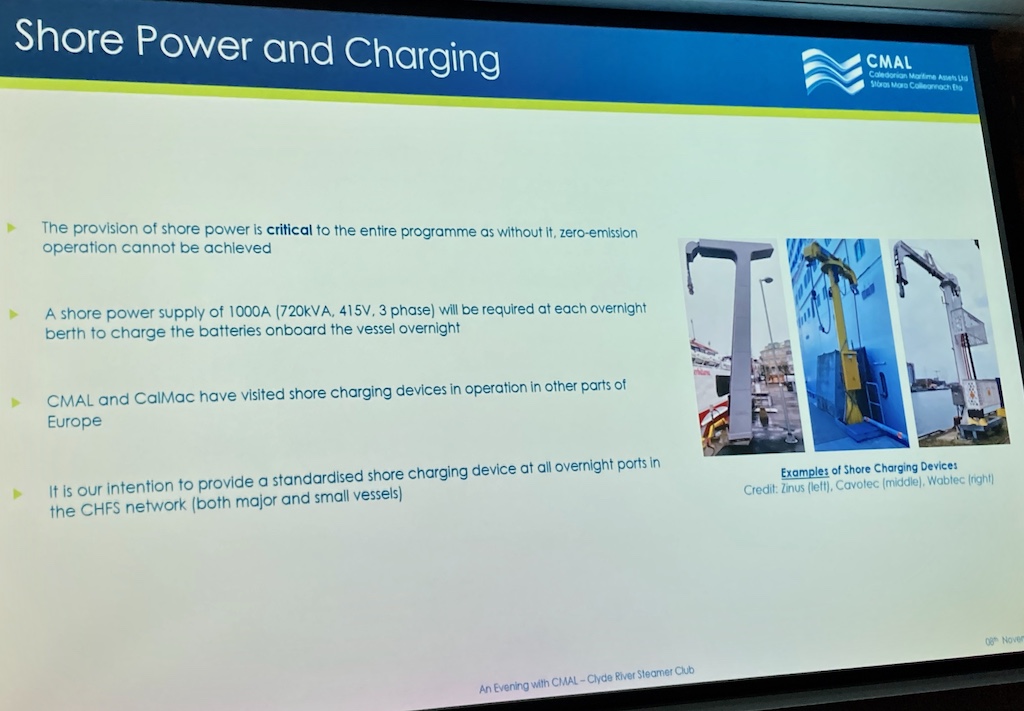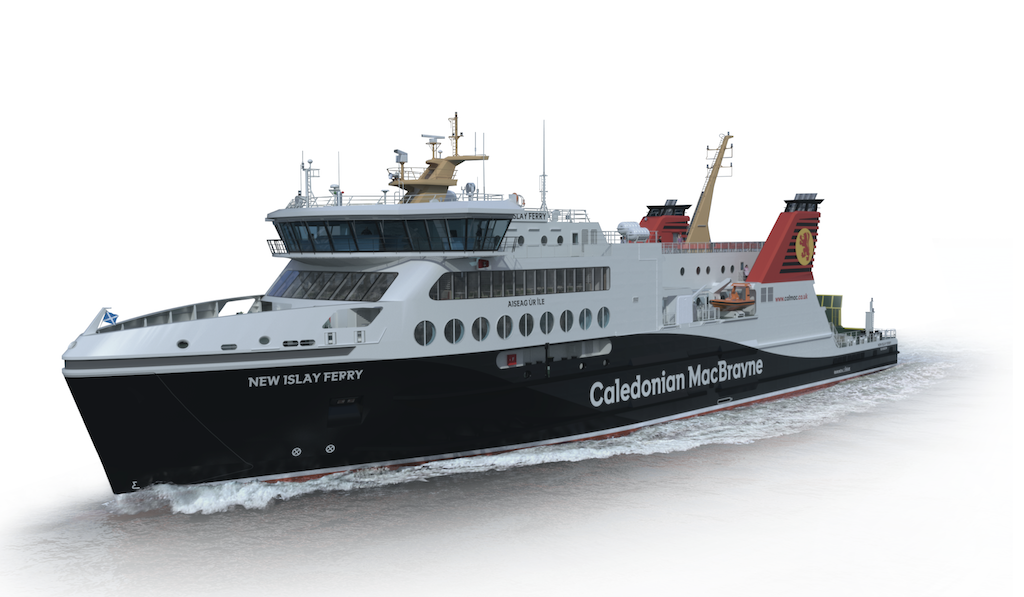
Computer-generated illustration of the four near-identical ferries currently being built in Turkey for the Islay service and the Uig triangle
After a substantial hors d’oeuvre with CalMac’s chief executive last weekend in Rothesay, CRSC members gathered in Glasgow on Wednesday for a second course, this time courtesy of Caledonian Maritime Assets Ltd (CMAL), the organisation which procures and owns the ferries operated by CalMac. Below, Stuart Craig offers his impressions of the evening. In a separate post, paid-up CRSC members can watch a complete video of the CMAL presentation.
We were delighted to welcome Jim Anderson, CMAL’s Director of Vessels , and two Technical Managers, Lewis Hammell and Declan MacDonald, to our 8 November meeting in the Maldron Hotel. Each took a turn to outline, in considerable detail, their plans for a whole new fleet of ferries for Scotland’s west coast. They explained the specification of the four big vessels under construction at the Cemre Shipyard in Turkey, gave us an internal photographic tour of Glen Sannox and Glen Rosa at Ferguson Marine, Port Glasgow, and disclosed CMAL’s plans for 10 smaller ferries. This was all new information.
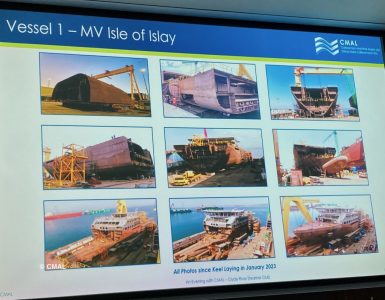
The CMAL presentation included a sequence of photographs of MV Isle of Islay, covering the past 11 months of construction at the Cemre Shipyard in Turkey. Isle of Islay will be the first of four near-identical ferries to be completed, with a launch date expected in January or February 2024. Click on image to enlarge
Jim, who has 40 years’ experience of designing, constructing and commissioning vessels, has been with CMAL since 2009. He emphasised that the company’s vision for west coast ferries was to add resilience, reduce emissions and improve standardisation: “We aim to have an average ferry age of 15 years, and to replace any vessel once it reaches 30 years old. From procurement to the entering into service for a ship is a five years process.”
The message here was: look out Clansman, Hebrides, Bute and Argyle – your days are numbered!
Jim then handed the microphone to Lewis, who spoke concisely and eloquently about the specification and progress of the Turkish fleet. There was plenty of detail on the four near-identical ferries, all of which should be delivered by October 2025. And there was one small reassuring fact: their stabilisers are being built in Dunfermline!
Next was Declan, who gave an equally assured and informative presentation. There are plans for 10 double-ended ferries to replace Isle of Cumbrae, the four 1986 ‘Loch’ class vessels and perhaps one or two others by the end of 2028. These will be battery-powered but with back-up diesel generators. It has not yet been decided where these will be built.
Some snippets in the presentation caught my attention. If the new smaller ferries were to operate on an assumed 345 days in a year with battery power only, their CO2 emissions would be down 96% compared with a diesel-powered vessel. And regarding slipways, the approaches to many of these will have to be dredged before these ferries enter service.
We were then given some background information on the procurement of Loch Frisa and Carvoria. In the hunt for the former, around 70 vessels were considered — all but one of them rejected due to the specific difficulties of operating on our west coast, due to the shallow waters and extreme tides here. For example, when operating in Norway, Utne (now CalMac’s Loch Frisa) did not require depth-sounding sensors, as the waters in which she operated were 5,000 feet deep!
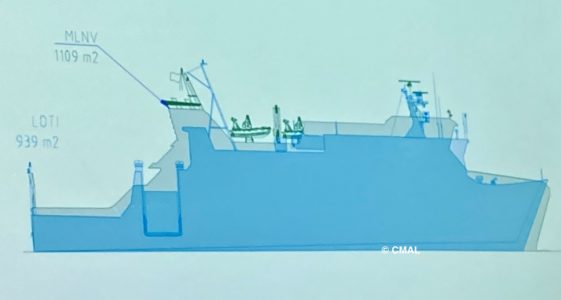
Embryonic design model comparing Lord of the Isles (dark blue) with a possible replacement vessel (lighter blue). Due to harbour limitations at Mallaig, the LOTI replacement will be higher but not substantially longer
Jim finished the presentation by offering us some of CMAL’s plans for the replacement of Lord of the Isles.
Both Mallaig and Lochboisdale present problems in terms of space for manoeuvring, which means that LOTI’s replacement can be no bigger than her. A new terminal at Gasay Island next to Lochboisdale is being considered.
Some well-informed questions were asked by the audience and given full answers by our guest speakers. I was pleased to hear that Caledonian Isles will be retained for the foreseeable future, and that CMAL are satisfied with the considerable work recently carried out on Hebridean Isles. James also conceded, in response to a question, that building two new LOTIs might be worth considering!
This was a fascinating evening, thanks to the insights provided by three gentlemen immersed in their subject. As a Club we feel honoured to have had them with us — and are extremely grateful to both CalMac and CMAL for providing us with their top chaps over the past week, reassuring us that the ferry services we love so much are entering brighter waters.
CRSC President Robin Copland thanked Jim, Lewis and Declan for giving their time to speak to us. For me — lessons from the Glen Sannox debacle seem to have been learnt, and with all these new ferries in the pipeline, I can’t wait to sail on them.
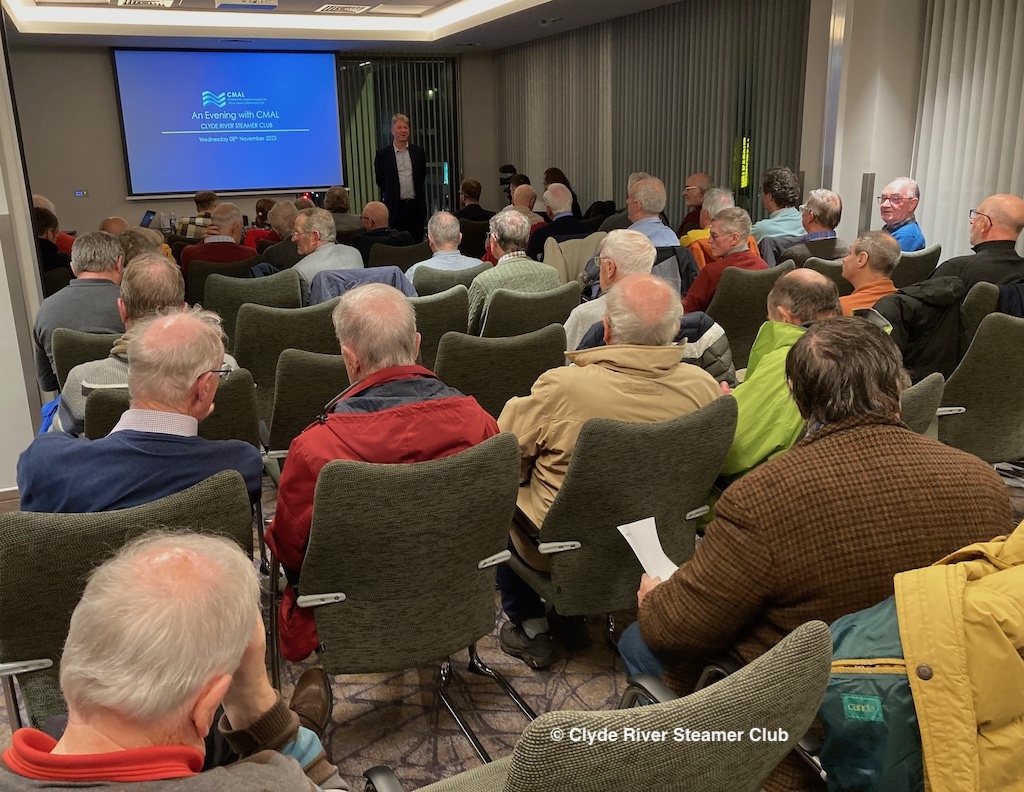
Jim Anderson (in background) with CRSC members before the start of the CMAL presentation at the Maldron Hotel
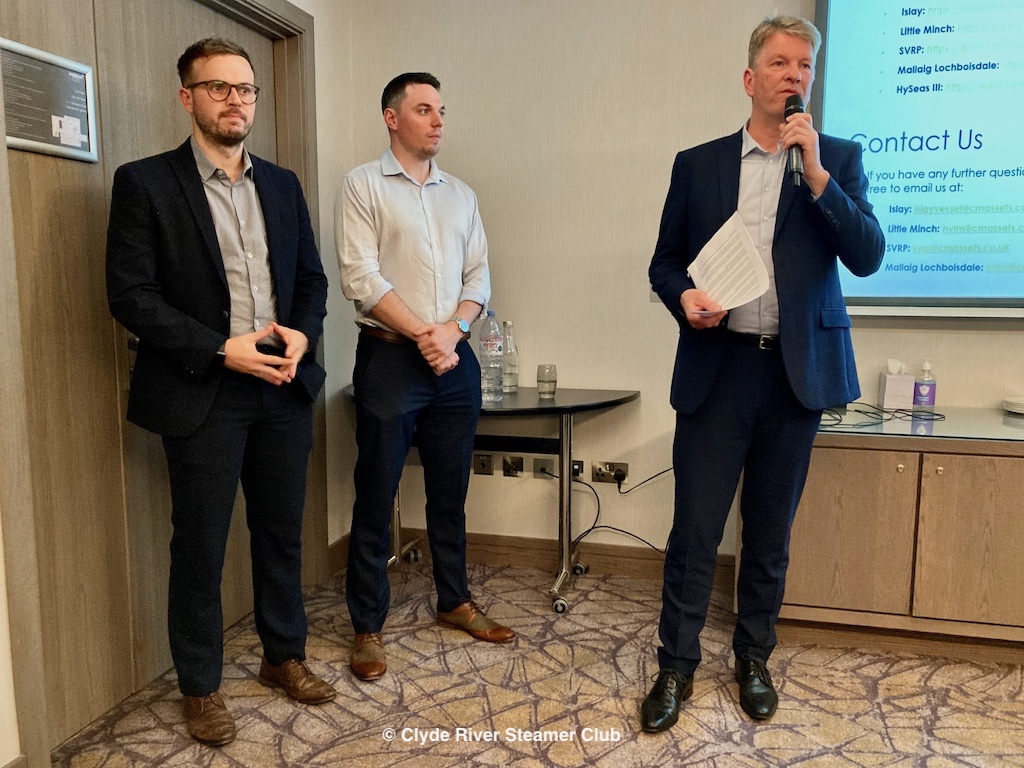
Jim Anderson (right), with Lewis Hammell (left) and Declan MacDonald (centre), answers CRSC members’ questions after the CMAL presentation
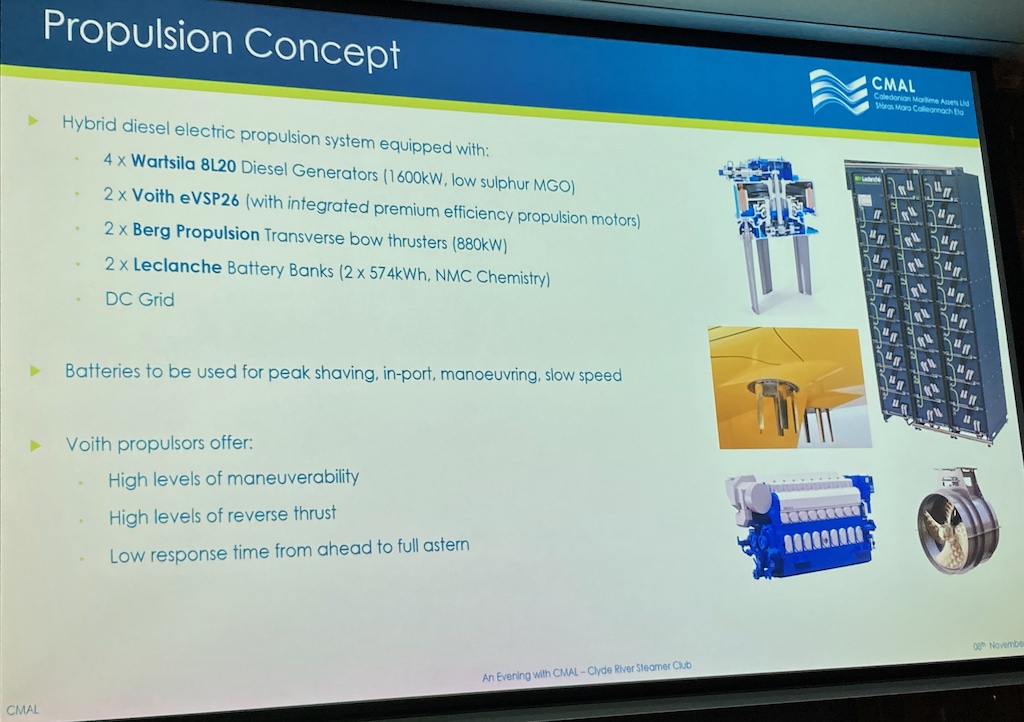
Details of the propulsion concept for the four big Turkish-built ferries: large Voith units powered by diesel-electric

There was no shortage of detail on the Small Vessel Replacement Programme, even though none of the ferries has been ordered and some elements of the design have still to be settled
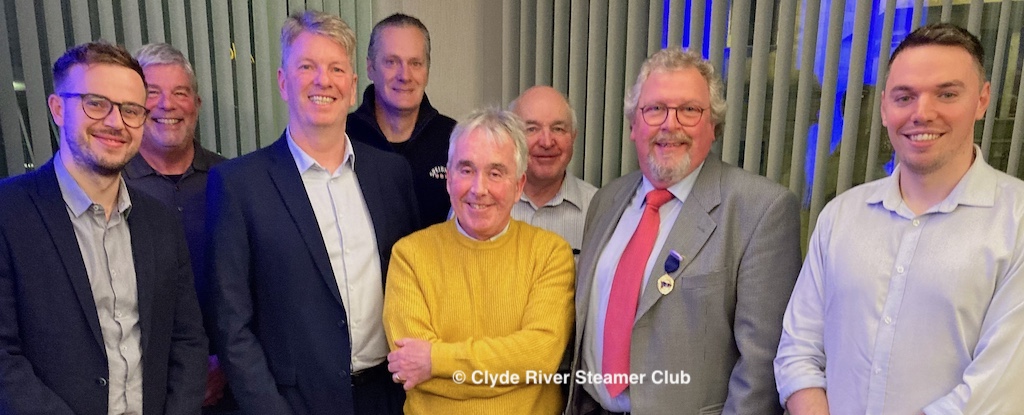
After their presentation, Jim Anderson (third left), Lewis Hammell (far left) and Declan MacDonald (far right) were thanked by numerous CRSC members, including Brian Shaw, James Fisher, Mike Smith, Graham Lappin and our president, Robin Copland, who chaired the meeting
If you join CRSC, you will have access not only to the video of the CMAL talk, but also to a large online library of ‘Members Only’ posts containing dozens of videos and hundreds of archive photographs. Click here to join for £15.
Published on 11 November 2023












